by Lorri | Oct 3, 2012 | Tips, UnCorked
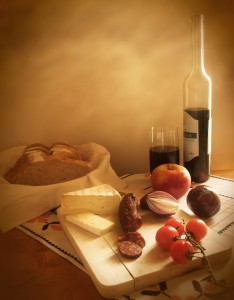 There really are a few ground rules in wine and food pairing, well not really “rules” but more like advice to keep in mind.
There really are a few ground rules in wine and food pairing, well not really “rules” but more like advice to keep in mind.
Follow the logic of the recipe. If a dish contains a certain red or white wine or even beer it generally makes sense to pair the same or a similar bottle with it. If your recipe is a sweet chocolate dessert with raspberries and cherries move in the same progression with a sweet red wine. If the pasta sauce calls for a few dashes of dry red or white wine the same will most likely match the dish.
Put out of your mind most of the rules you’ve heard. “Red wine with red meat” and “white wine with fish” worked for past dining rules but with today’s food fusions it does not always hold true. The only advice most experts agree on is to remember to drink dry wines before sweet wines, light-bodied wines before full-bodied and your wine must always be sweeter than your dessert.
Some foods and wines naturally flatter each other. These are classics for a reason – the match rarely fails. Apple or pear tarts and dessert wines, truffles or mushrooms and pinot noir, lobster and white Burgundy, roasted meats and most red wines, oysters and Champagne, Stilton cheese and port, goat cheese and sauvignon blanc and chilled dry fino sherry with roasted nuts.
Respect tradition – but not unquestioningly. Many countries, Italy and France to name a couple, have been pairingwines with certain dishes for centuries. There may be other pairings but why struggle to find new ones when they have already been perfected.
Chicken is much more than just chicken. Very rarely do we eat simple plain chicken dishes without a sauce or roasting, grilling or basting method. The starting point for chicken pairings can be found in the sauce or marinade. There’s quite a contrast between a delicate cream mushroom sauce and Thai green curry chicken, so consider the overall dish and not simply the chicken. (Same applies to most meat pairings.)
Don’t forget the sides. Generally most vegetables accompanying the meal won’t be powerful enough to dominate the main dish. But if your sides feature strong flavors such as onions, spicy salsas, cabbage or peppers you may need a more full-bodied wine to compete with the flavors.
by Lorri | Sep 26, 2011 | Tips
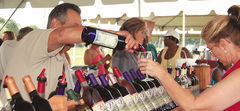 It’s easy to get impatient as you begin the journey to wine knowledge and enjoyment. Progress is slow — a glass here, a bottle there.
It’s easy to get impatient as you begin the journey to wine knowledge and enjoyment. Progress is slow — a glass here, a bottle there.
But sometimes-wine enthusiasts get a chance to progress by leaps and bounds instead of the baby steps of a taste here and a taste there. Local, Regional or National Wine festivals provide the opportunity to expand your horizons. Responsibly navigating your way through those hundreds of wine choices, however, takes patience and strategy.
WHAT TO EXPECT
As with any large, public event, wine festivals will give you a great opportunity to socialize and compare notes with other wine enthusiasts. Yes, you’ll taste wines, and lots of them, but you’ll also explore the world of wine.
Books have been written on how to develop professional tasting skills, but remember that the goal of your evening is not to judge the wines for the commercial wine trade, but for your own personal discovery and enjoyment. Your goal? Walking away with a heightened appreciation of the wonderful world of wine … and, of course, a list of some new favorites.
DISCOVERING THE WINES
Whether in the privacy of your home, a restaurant in Paris or at the next wine festival, you want to remember the wines you taste. Think of and classify them by color, aromas and taste. No need for fancy terms or the latest wine vocabulary. Keep it simple.
Look at the wine for color. If you thought wine was only red or white, take a closer look to discover the pinks, golden yellows, green tints, purple or even black colors that fill your glass.
Smell the wines for familiar aromas. Take the glass by the stem and give it a swirl to maximize the aromas. Don’t feel awkward placing your nose deeply into the glass to detect the aromas. You may smell simple fruits, smoke, citrus or even your grandmother’s rose perfume. It is the aroma that will help you remember what you enjoyed about the wine, grape or country of origin. (If you find the entire concept of swirling, smelling and tipping the glass a bit intimidating, practice at home with your wine at dinner or even water in a wine glass over the kitchen sink.) And finally— the moment you are waiting for and the reason to attend the event— taste. Swirl the wine in your mouth. Does it feel heavy or light? Does it taste sweet (like sugar on the tip of your tongue) or dry (complete lack of sweetness)? Does the wine have strong tannin or subtle tannin (a drying effect on the gums and sides of the mouth)? Think of the incredible taste descriptors as it fills your palate. It may be strawberry, lemon, nuts, berries, tobacco or even licorice.
Stay with these simple tips and you will discover wines that range from easy drinking to complex masterpieces, and remember, it’s only your personal enjoyment of the wine that matters.
TASTING BY CATEGORY
If the thought of having hundreds of wines at your fingertips is an overwhelming concept, try tasting them in groups. Easy methods include: By countries: Australia, Spain, Chile, Germany, etc.
By regions in big wine-producing countries: For France, Burgundy, Bordeaux or the Rhone Valley; in California sample wines from the Central Valley, Napa and Sonoma.
By grape varieties: cabernet sauvignon, chardonnay, sauvignon blanc, merlot or pinot noir.
This way of navigating big wine events lets you compare and contrast large amounts of wines you may not have had the opportunity to taste in one setting.
TAKE NOTES
Most tasting events offer listings of wines and ample room for jotting down notes. Take advantage of the note-taking to remember these wines after the event has ended. You can organize thoughts according to color, aroma and taste, or use a simple technique called “scribble” — stars, smiley faces, “best value”, “try with fish from Susan’s recipe” or even “great gift idea for Aunt June next Christmas.” The good news is that only you will be reviewing these wine notes later at home, so no need to focus on fancy details.
SPIT AND SPIT OFTEN
The last and possibly most important tip for large tasting events is acknowledging that the key word is “tasting” not “drinking.” If you plan on trying a large number of wines, you will definitely want to become well acquainted with the spittoon. Remember: Spitting is part of the tasting process and not a social faux pas. A responsible tasting atmosphere will only offer a quarter-glass pour. Don’t be offended by the amount of the pour or even feel embarrassed to dispose of excess wine into spittoons. It is all part of the tasting atmosphere, so you can have the fullest enjoyment of the evening.
TAKE ADVANTAGE
Remember, if you love wine, wine festivals supply a rare and incredible opportunity to sample a lot and learn a lot in a short time. To replicate the experience on your own would take hundreds of days and hundreds of dollars.
And you don’t even have to feel guilty for spending the modest amount of money required to get a ticket — it goes to a great cause.
by Lorri | Jun 23, 2011 | Tips
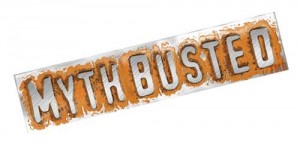 I am always looking for interesting ideas and this past week my inspiration light bulb came while watching the Discovery channel show MythBusters with my children. It had me thinking of the many questions surrounding the mounds of contradictory advice in the wine world. As with many myths some are handed down from experts, some tradition and sadly, most woven in by pseudo experts. So Mythbuster style, here are some wine myths and my take on if they are confirmed, plausible or busted.
I am always looking for interesting ideas and this past week my inspiration light bulb came while watching the Discovery channel show MythBusters with my children. It had me thinking of the many questions surrounding the mounds of contradictory advice in the wine world. As with many myths some are handed down from experts, some tradition and sadly, most woven in by pseudo experts. So Mythbuster style, here are some wine myths and my take on if they are confirmed, plausible or busted.
Wines should be served in distinct glassware.
Wine professionals will often taste hundreds of wines side by side. During my humble 10 years judging on panels my “tasting” glass continues to be the ISO glass. At most events we use a single glass through whites, reds, ports and sweets. For most, it is the detergent used for washing the glass that is more distracting than the traces of the previous wines. That being said, professional tasters are not having an experience of drinking wine over a lovely meal where the rows of glasses for several courses offer a picture-perfect dining encounter. Master of wine and author Jancis Robinson thoughts, “The practicalities of having a set of the perfect gasses for each wine type defeat me and my cupboard space. The main thing is have a clear glass that is as thick as possible with a bowl on the stem that goes in towards the rim so that you can swirl to release aromas without losing either wine or vapor.” Plausible, in the sense that a wine glass will offer more enjoyment than say, a paper cup. But for the most part busted.
You must always smell the cork when the waiter hands it to you.
The purpose of the waiter offering the cork is so the consumer can check to see if the cork is broken or for the presence of mold. The process of smelling the cork does not indicate the quality of the wine or if it has been tainted from the cork. The only way of confirming if the wine is clean is by tasting. Busted.
Wines should be decanted before serving.
Professor Emile Peynaud (1912-2004), world-renowned scientist, taster and teacher, argued that oxygen coming in contact with a sound wine does more harm than good. His theory was that the longer the wine was aerated during decanting the more diffuse its aromas and less marked its sensory attributes. He advised to only decant wines with sediment and only just before serving. This theory is easily proven in fragile, fully developed 20 to 30 year old wines. Many of these wines are so delicate they can only withstand minutes in a glass before giving in to the negative impact of aeration, which is oxidation. Busted, with the exception of wines with sediment.
The “legs” or “tears” can judge the quality of a wine.
The “legs” or “tears” are the viscous streams that run down the inside of the glass. If you swirl the glass, the “legs” are more noticeable. More pronounced legs do not indicate quality, only a higher amount of alcohol. Busted.
You should age all red wines.
By no means does every wine improve with age. As much as 98 percent of still wines (those excluding sparkling and fortified) are produced to be consumed within a few years. Confusion around this myth is why many people are sadly disappointed when they open saved bottles only to find that the wine has turned to vinegar. Busted.
by Lorri | Jun 22, 2011 | Tips
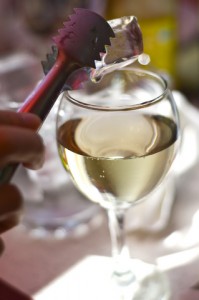 As summer heat bears down on us, it seems the appropriate time to answer a few questions that wine lovers have been asking.
As summer heat bears down on us, it seems the appropriate time to answer a few questions that wine lovers have been asking.
Can you drop a few ice cubes into your white wine to give it a quick cool down?
It seems the perfect answer to quickly cooling down a glass of wine, but actually it can alter the taste and balance. Wine, unlike many beverages, is produced with a perfect balance of water, sugar, acid, tannin and alcohol. The vineyard manager and winemaker devote time to grow and produce grapes to achieve this perfect balance. Dropping in a few ice cubes leaves it watery with the taste of a poor quality wine. Instead, try a rapid wine-chill by placing the bottle in a half-water, half-ice solution for about 10 minutes or a quick freezer-chill for 10 to 20 minutes.
Can wine really go bad from heat inside the car?
When the wine is subjected to a temperature over 100 degrees, you can be sure its quality will be jeopardized. This can happen when you buy a couple bottles of wine, place it them in the trunk and continue on your errands as usual. I like to I treat wine as I would ice cream. You wouldn’t buy ice cream and leave it in the car while you run errands or have dinner with friends.
I am looking for a cool refreshing wine to go with burgers and the weather is too hot for reds. Any suggestions?
Rose, Rose, Rose (ro-zay). This perfect summer wine offers the cool refreshing characteristics of white wine. I will stay on my rose wine soapbox until I am confident that wine lovers have given them a fair try.
by Lorri | Jan 16, 2010 | Tips
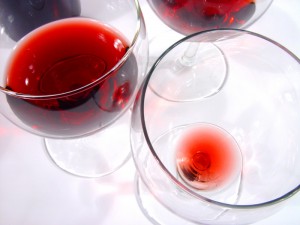 Here are a few tips to help you get the most out of a wine bar experience.
Here are a few tips to help you get the most out of a wine bar experience.
Take advantage of exploration: A wine bar will give you an opportunity to explore every hot spot in the world of wine. Don’t be afraid to try something new. Ordering by the glass, you can compare the ordinary, the safe and even the bizarre. When dining out, most of us do not order the same old chicken or steak on a restaurant menu. It’s the same with wine; step outside of Chardonnay and Merlot.
Be aware of storage conditions: If you see hundreds of bottles lining the serving area with out even a cork in them, you may not be getting the best sample of that wine because of the oxidation that occurs when it is exposed to air. Wine bars spend a lot of money on storage methods for keeping wines fresh, and the most reputable of these bars will have the most modern systems of preservation.
You can send it back: Don’t be afraid to send back a glass of wine that tastes oxidized or old. Just like a green apple that is left out in the air, wine loses some of its freshness if it is not preserved properly. Most wine bars will respect this request.
Order a taste, instead of a full glass: A taste is usually about a 1-ounce pour. This is a fun way to explore wine.
Order flights: One of the best advantages of a wine bar is being able to order several different wines. For example, you could ask for flight of Cabernet Sauvignons from four different growing regions, three from the top producers of Bordeaux, or a three unique or odd wines you have never tasted.
Enjoy!
by Lorri | Jan 8, 2010 | Tips
 When it comes to pairing wines and chocolates, remember that lighter, more elegant chocolates generally should be tasted with lighter-bodied wines. If the wine is more full-bodied, the chocolate should be stronger, darker and more robust. For example, a delicate Moscato d’Asti could compete perfectly with the mellow butter flavors in many white chocolates.
When it comes to pairing wines and chocolates, remember that lighter, more elegant chocolates generally should be tasted with lighter-bodied wines. If the wine is more full-bodied, the chocolate should be stronger, darker and more robust. For example, a delicate Moscato d’Asti could compete perfectly with the mellow butter flavors in many white chocolates.
The wine should be at least as sweet, or possibly sweeter, than the chocolate served with it. Many times when the wine and chocolate are not compatible, a slight sour note develops on the palate.
Framboise, with its raspberry flavor, works beautifully with white or milk chocolates.
Cabernet sauvignon is another great match for chocolate, because it also has the aromatic hints of dark berry, spice and even chocolate.
A combination of chocolate with red wines that are overoaked or start as extremely dry wines, such as Spanish Riojas, will likely take any sweetness from the chocolate and fruitiness from the wines, leaving a taste similar to a dust bowl. Try a robust, full-bodied California Zinfandel or an Australian Shiraz for exceptional pairings.
Any Port or dessert wine is considered the traditional “safe bet” with almost any type of chocolate, but remember, unlike many other foods, such as cheese and hearty meat dishes, there really are no “safe bets” with chocolate.
For the best results in your pairing exploration, stay with fine wines and high-quality chocolates. Chocolate shaped like a bunny and wine that costs less than $5 a bottle are not the most ideal matches for this challenge of the senses.
 There really are a few ground rules in wine and food pairing, well not really “rules” but more like advice to keep in mind.
There really are a few ground rules in wine and food pairing, well not really “rules” but more like advice to keep in mind. It’s easy to get impatient as you begin the journey to wine knowledge and enjoyment. Progress is slow — a glass here, a bottle there.
It’s easy to get impatient as you begin the journey to wine knowledge and enjoyment. Progress is slow — a glass here, a bottle there. I am always looking for interesting ideas and this past week my inspiration light bulb came while watching the Discovery channel show MythBusters with my children. It had me thinking of the many questions surrounding the mounds of contradictory advice in the wine world. As with many myths some are handed down from experts, some tradition and sadly, most woven in by pseudo experts. So Mythbuster style, here are some wine myths and my take on if they are confirmed, plausible or busted.
I am always looking for interesting ideas and this past week my inspiration light bulb came while watching the Discovery channel show MythBusters with my children. It had me thinking of the many questions surrounding the mounds of contradictory advice in the wine world. As with many myths some are handed down from experts, some tradition and sadly, most woven in by pseudo experts. So Mythbuster style, here are some wine myths and my take on if they are confirmed, plausible or busted. As summer heat bears down on us, it seems the appropriate time to answer a few questions that wine lovers have been asking.
As summer heat bears down on us, it seems the appropriate time to answer a few questions that wine lovers have been asking.
